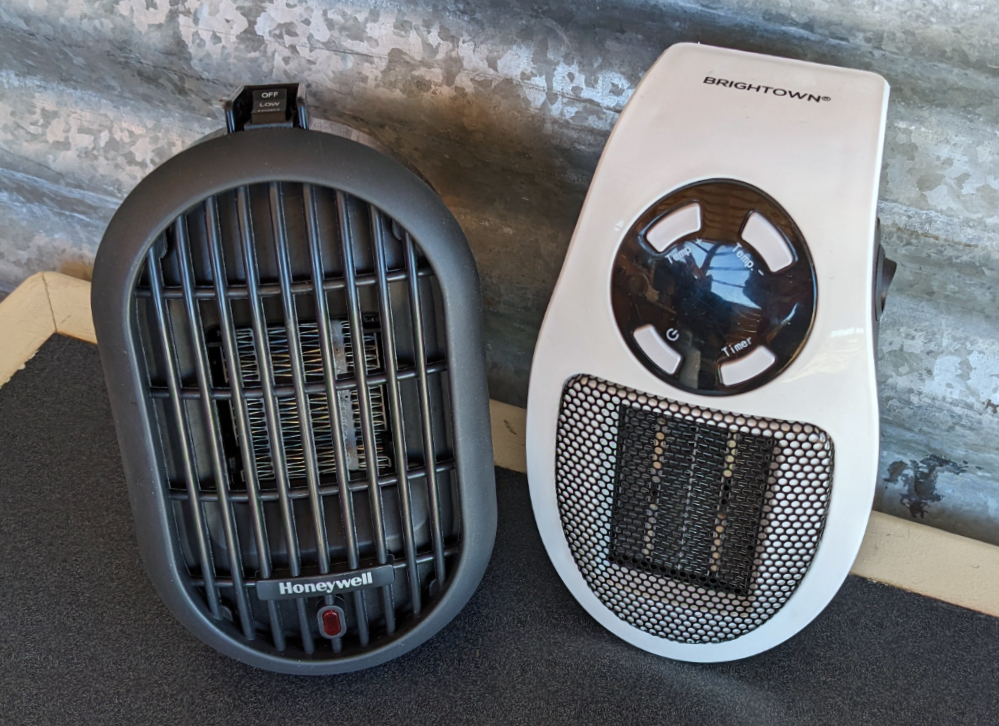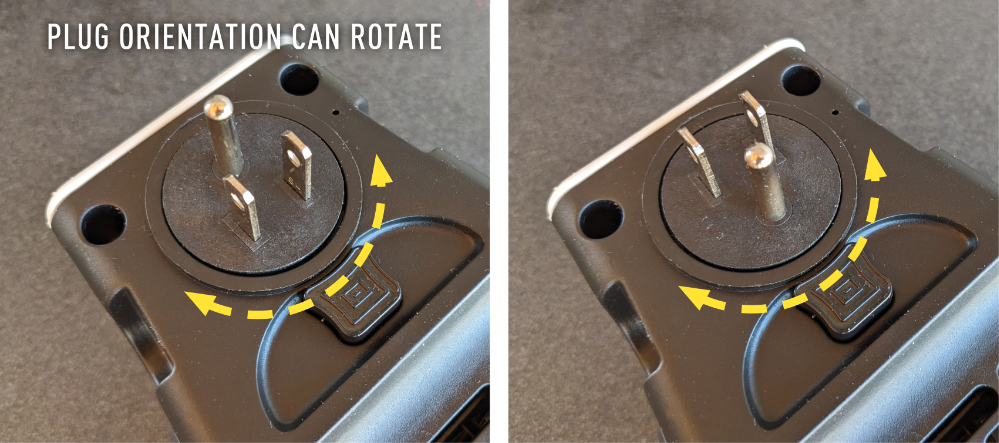I WAS READING AN ARTICLE ABOUT ELECTRIC VEHICLES when I came across a statement that applies to us nomads. The story was about the intersection of two problems when heating EVs. One, the lithium-ion batteries used in EVs produce less electricity in cold weather, decreasing vehicle range. Two, using the batteries to also power heating devices further decreases range.
Okay, fine, but what does that have to do with you? You don’t have an EV. Yet. Maybe never. This is the relevant part of the article [my emphasis added]:
While manufacturers have attempted to keep occupants cozy with heat pumps and resistive heaters, the simple truth is that resistive heating is incredibly power-hungry. ~Autopian, Jan 5 2023
Resistive heat is created by resistance of some type in the electrical circuit. It’s intentional inefficiency. In non-scientific terms, the heating element can’t pass along all the power sent to it, so it releases some of the electricity as heat. In order to warm a space, several heating elements need to be fed a lot of electricity — probably more electricity than the average off-grid nomad can produce with solar.

What about those little heaters?
Small ceramic heaters like these two, rated for 250 and 350 Watts, use only a fraction of the power the typical 1,500 Watt space heaters use. But they also put out a fraction of the heat. However, the space you want to heat is only a fraction of the typical room. So they should be a viable option for keeping you from freezing in your rig, right?
Fortunately, we don’t need to guess. “Nowhere Gal” put the Honeywell Heat Bud to the test in her van. She plugged it into her 1000Wh power station where it drew a little less than the claimed 250 Watts on the high setting. After an hour the temperature in her well-insulated space had risen from 30°F to 40°F (-1°C to 4.4°C). Her power station started with a 94% charge. At the end of the hour it was down to 70%

“We’re looking at 24 percent of my battery drained in one hour. Just do the math and figure out that’s probably not the best way to heat a freezing van,” Nowhere Gal concluded.
That was with a lithium battery which can use nearly 100% of its rated capacity. If you wanted to do this with a lead-acid battery, you could use only 50% of its rated capacity before damaging the battery.
Nowhere Gal repeated the test when her van was at 50°F/10°C. The temperature had risen to 60°F/15.5°C after a half hour while the power dropped 11%.
“If your van is already at a decent temperature, it kind of kick-starts it and it will help, but it still is a really big draw on the power station. So just keep that in mind if you’re considering electric heat.”
If you’re using solar to recharge your power station or house batteries, you also need to consider the short days and frequent cloud cover of winter.
What about that other small heater?
The other heater I bought is sold under many names, Brightown in this instance. It’s rated at 350W at 20°C — and 400W at 0°C. I suppose that’s because it has a thermostat (rather than just a high-low-off switch like the Heat Bud) and needs to draw more power to achieve the desired temperature in cold environments.
Testing the Brightown was a little tricky because it’s designed to plug directly into a wall outlet. There wasn’t enough clearance to plug it into my inverter, so I had to scrounge up an extension cord then rig a way to prop up the heater. That probably wouldn’t be a problem if you’re using a power station, but I wonder if a heat source that close to the power station would cause problems.

Both the Brightown and Honeywell Heat Bud produced a somewhat annoying aroma the first few times they were used, but the Brightown was more pronounced and lasted longer. I don’t know whether the smell would affect those with chemical sensitivities.
But like the Heat Bud, the Brightown is a small heater trying to do a lot of work. That means a lot of power use for only a few degrees of warmth. And, really, they weren’t designed for our purposes. They were meant for spot heating in places where the standard heating isn’t quite enough, like under a desk in an office that management keeps too chilly for you. (Ugh, office life.)
However one positive thing about power-hungry electric heat is that it doesn’t produce moisture like fuel burning devices do. So if you’re camped where you have abundant shore power, forget these small heaters and stay warm and dry with one of the 1,500W heaters.

Great article Al. I’ve always wondered about those tiny plug-in heaters, thanks for reviewing them! I believe I’ll end up getting some nice (large) rocks, heat them in the campfire and put them on my bed to warm it. When the power went out here earlier this month, I plugged in a heating blanket to my small Jackery and it drained 20-25% of the power in 2 hours. So that’s not a great option for people with limited power options.
Rocks lose about 100% of their heating power in two hours. 🙂
But, with the bed prewarmed your body heat can maintain heat for a longer period of time. Do watch for exploding rocks in the campfire, though.
I pre-warm my bed by getting in with all my clothes on then stripping down as I get too hot. 😀
I see the problem — using brute-force to heat the entire interior.
My solution — gently heat the human.
.
Instead of raising the temperature of the interior structure plus all the components, how about just heat the person:
* a 12vdc heating-pad or blanket.
* a 12vdc motorcycle vest and gloves.
* a nice beef-stew, some tea.
* a couple-three dogs.
Yes, I like the idea of dogs, plus they have their own coats and won’t hog your blankets hopefully, unless we’re talking about Chihuahuas here?
The best way I know to heat my rig is to head down to the tip of Texas and camp there near Brownsville. Been doing that for 15 years.
I think that’s what my future will hold as well. Southwest areas with mostly abundant sunny, warm days and not so cold nights. I went to visit a patient early this morning and it was 10 degrees here in Reno? A balmy 38-42 degrees overnight would be great!
You need to mind the elevation, though. I’m in southwest New Mexico but at 6,000 feet. We’ve been having nights in the 20s.
That’s cold. Funny you should say NM cause I was thinking Las Cruces would be a great winter spot. I lived at WSMR in the 70s as a kid and loved it there, but can remember cold, winter nights now that you mention it.
I agree with Marge; contact heating > space heating when using electricity one makes offgrid. Dogbeest and I are quite fond of the electric mattress pad (avg 13 on lowest setting).
Having said that, I have copious solar on the van and bought a 250w heater to experiment with. It is one of the few appliances I’ve tested that actually pulled what it said on the label.
On clear days in winter I can run the heater “off the panels”. It does make a difference. I have it either have it pointed at me while working at the galley or toward the bed platform cubby hole while relaxing.
Of course, one can get a similar result by running something long-cooking i a crockpot or similar. I have also suggested, only half-jokingly, that one could mine cryptocurrency with excess solar since POW rigs generate a lot of heat.
If the only thing you need to keep warm is your body overnight, then heating the whole sleeping space does not make sense. A mattress pad is an excellent idea and I believe they shut off after 8-10 hours for safety. That, and a dog for cozy burrito warmth?
I’m not a nomad, more a camper, but have a tiny propane-powered catalytic heater for my van. No one is mentioning propane heating but I see lots of heaters on Amazon. Is there an inherent problem with using a propane heater? (I’m assuming they are safe to use…. since they are sold as indoor heaters).
We’ve talked a lot about propane heaters here at CRVL. You can check the Learning section of the site or just do a search for them. There’s another article about a propane heater coming up this week. We’ve done a series of electric heaters this season because people have been curious about them.